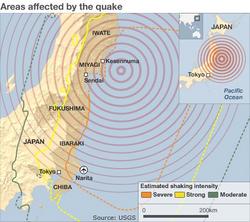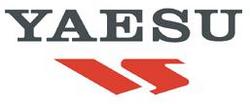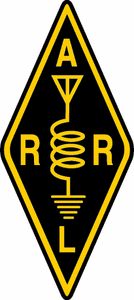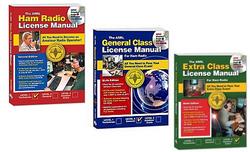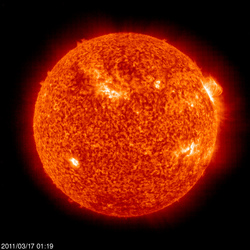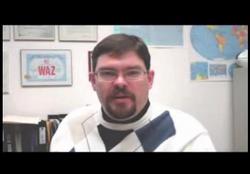 March 17, 2011 John E. Ross, KD8IDJ, Editor
| |||||||||||||
+ Public Service: After Devastating Earthquake, Japan's Radio Amateurs Provide Communications Support
After the 8.9 earthquake that struck near Sendai, Japan at 2:46 PM JST (0546 UTC) on Friday, March 11, the island nation is trying to recover. Soon after the earthquake -- which the US Geological Survey is calling the largest to hit the island nation in 140 years -- Japan has been rocked by tsunamis and power outages caused by trouble at a nuclear power station. Reports from Japan tell of phone and Internet service still up in most parts of the country. Even so, the Japan Amateur Radio League (JARL) -- that country's IARU Member-Society -- has asked that 7.030 MHz be kept clear for emergency use. Other reports are asking that these additional frequencies be kept clear: 3.525, 7.030, 7.077, 7.087, 7.097, 14.100, 21.200 and 28.200 MHz. JA1RL, the JARL HQ station -- along with other amateurs throughout the island nation -- is maintaining the effort to support the disaster relief operation, according to IARU Region 3 Secretary Ken Yamamoto, JA1CJP. "In less damaged areas, the electric power supply is being restored gradually and local amateurs have started to establish stations at shelters," he said. Yamamoto said that JA1RL continues to operate as an emergency traffic center on 7.030 MHz, as well as 2 meters and 70 cm. It is receiving and reporting news from Japanese amateurs who are in the affected area. Using battery power or small generators, Japanese stations are active and are using various frequencies to exchange rescue and disaster relief operation information with JA1RL and others.
"While 3.525, 7.030, 7.043 and 7.075 MHz have been mentioned as in use, it's wise to keep those -- and all of the Center of Emergency frequencies -- clear of normal and non-urgent traffic," said IARU Region 3 Disaster Communications Committee Chairman Jim Linton, VK3PC, who added that there is no call for additional foreign radio amateurs in Japan. For more on how radio amateurs in Japan are providing communications support after earthquake, click here. For information on how US amateurs are helping out, click here. For more on how Japan, Hawaii and the Western US dealt with the immediate aftereffects of the earthquake and tsunami, click here. + Yaesu, ICOM and Kenwood Issue Statements Regarding Effects of Earthquake on Operations
In a letter to the Amateur Radio community, Vertex Standard Chief Executive Officer and President Jun Hasegawa expressed his "sincere appreciation to all of you for your kind words and thoughts about us" after the devastating 8.9 earthquake that struck Japan last week. Vertex Standard is the parent company of Yaesu. All Vertex Standard employees and their families are safe and unhurt, Hasegawa said, but the company has not been able to reach many of their dealers and subcontractors who are located on the coast area: "We just hope that they are alive." Hasegawa said that a Vertex Standard factory in Fukushima was damaged in the earthquake. Even though the factory is not located near the coast and the damage was minimal, he said that Vertex Standard has decided to "disable the operation at this moment." Saying that they are working very hard to get the factory back to its normal operation, Hasegawa said that "it may take one to two weeks to restart operation in the Fukushima factory. I would like to ask for your understanding and cooperation at this time."
According to a press release, no one from ICOM is known to be injured. No damage has been reported at ICOM's headquarters in Osaka, or at either of their two main factories in Wakayama; both Osaka and Wakayama are located far south of the most severely affected areas. The branch offices in Tokyo and Sendai, however, did suffer some minor damage. "Most of ICOM's facilities and systems are ready to get back to normal business, but supplier logistics, commuting issues and future power disruptions will affect our company," the press release said. "It is too soon to tell how big an impact the earthquake and its aftermath will have on ICOM. We appreciate your interest and concern."
"Thankfully, our staff in Japan is safe due to earthquake preparedness and the special construction of our buildings," said Kenwood USA President Junji Kobayashi on the Kenwood website. "Power outages and interruption of mass transit have kept most of Kenwood's staff at home since the earthquake; however, we expect the infrastructure to improve in the coming week and our operations to fully resume accordingly. We appreciate the concern for our employees expressed by all those who have contacted us." Kenwood's primary office facilities in Yokohama and Hachioji were not damaged, due to their proximity further south and west of the quake's epicenter. Since Kenwood's primary manufacturing facilities are in Malaysia, electronics production is unaffected. + FCC News: ARRL Files Petition, Request for Temporary Waiver with FCC Regarding VHF Voice and Data Emissions
On Tuesday, March 15, the ARRL filed a Petition for Rulemaking and a Request for Temporary Waiver to authorize the use of single-time-slot Time Division Multiple Access (TDMA) emissions in the amateur bands at and above 50 MHz, wherever multiple-time-slot TDMA is authorized. The Petition asks the FCC to allow those amateurs who are presently using a Motorola narrowband (12.5 kHz) digital land mobile system -- commercially marketed as MotoTRBO -- to be used legally. Because of some restrictions in the Part 97 rules, the TDMA repeaters (which are multiple-time-slot devices) are legal, but the mobiles and portables are not because the emissions used (single-time-slot TDMA) are not authorized anywhere, due to the emission designator. Read more here. + Focus on Youth: Meet New ARRL Youth Editor Sterling Coffey, N0SSC
The ARRL welcomes its new Youth Editor, Sterling Coffey, N0SSC, of Warrenton, Missouri. Coffey is a freshman at the Missouri University of Science and Technology in Rolla, where he is studying electrical engineering. He said that since the age of five, he has been "intrigued and interested" in radio communication, crediting a gift of walkie-talkies "with a button and a letter diagram for Morse code." Read more here. + ARRL Recognizes: Nominations for ARRL Awards Now Open
Each year, the ARRL Board of Directors has the opportunity to select recipients for a number of awards in various categories that honor Amateur Radio operators. The nomination period is now open for those ARRL awards that recognize educational and technological pursuits in Amateur Radio. There are also awards to honor a young Amateur Radio operator and an outstanding ARRL Section Manager. Read more here. + On the Air: W1AW Announces Spring Schedule With the switch from Standard Time to Daylight Saving Time, W1AW Station Manager Joe Carcia, NJ1Q, has updated the W1AW operating schedule to reflect the change. The Eastern times have not changed, but the UTC times have. Read more here. ARRL Publications: Exam Software Now Included with ARRL License Manuals
Get a jump on your Amateur Radio license upgrade with ARRL license manuals. Now the manuals for the Technician, General and Amateur Extra class licenses include a CD-ROM, complete with exam review software. Each manual includes the complete question pool for its license class, including detailed explanations for all questions and answers. The ARRL Ham Radio License Manual -- Second Edition (valid through June 30, 2014), The ARRL General Class License Manual -- Sixth Edition (valid through June 30, 2011) and The ARRL Extra Class License Manual -- Ninth Edition (valid through June 30, 2012) will help you earn the privileges that come with upgrading your Amateur Radio license. Read more here. + Amateur Radio in Space: Hams Invited to Track Satellites
In November 2010, five research satellites were carried to orbit aboard a Minotaur V rocket from Kodiak Island, Alaska. Two of these satellites -- FASTRAC 1, known as "Sara Lily" and FASTRAC 2, referred to as "Emma" -- entered orbit as a single nanosatellite, but on March 15, scientists sent the command to have them separate. According to FASTRAC Student Program Manager Sebastian Munoz, KE5FKV, students at the University of Texas will be confirming the separation as the satellites pass: "We started one of the most exciting phases of our project by separating both of our girls so that they can compute on-orbit real-time relative navigation solutions while both of them are freely drifting from one another." Munoz said that they will continue to update the satellites' two line elements (TLEs) on their website for those radio amateurs interested in tracking the two nanosatellites. "I want to thank the ham community all over the world for supporting our project," Munoz said. "Your support has been incredible and we really value it. We really appreciate all of your help so far and we hope that we can continue to count on it." Solar Update
Tad "And look, the Sun is in the sky" Cook, K7RA, reports: The average daily sunspot numbers this week plummeted 45 points to 69, while the average daily solar flux was off nearly 25 points to 114.5. Last Friday, March 11, the planetary A index reached 40 due to a powerful X1.5 class solar flare at 2323 on March 9. This is another definite indication that Solar Cycle 24 is ramping up. After four years of no X-class flares, there have been two in the last month. The past few days have seen very quiet geomagnetic conditions, with the K index in most locations at 0. The latest forecast shows quiet conditions with planetary A index around 5 until March 27-30, when the predicted planetary A index is expected to rise to 7, 7, 19 and 7. The predicted solar flux for March 17-26 is 90, 85, 80, 85, 90, 95, 100, 110, 85 and 85. This Sunday is the spring equinox in the northern hemisphere, a welcome sign for DXers everywhere. Look for more information on the ARRL website -- including reports, anecdotes and observations on propagation and an explanation about how the geomagnetic A index is calculated -- on Friday, March 18. For more information concerning radio propagation, visit the ARRL Technical Information Service Propagation page. This week's "Tad Cookism" is brought to you by the song Cool, Cool Considerate Men from the musical 1776. ARRL Executive Committee to Meet this Weekend The ARRL Executive Committee will be meeting this weekend in Chicago. The agenda for their March 19, 2011 meeting is now available. + ARES® E-Letter Now Available in Audio Form
The ARES® E-Letter is now available in audio format. There are three editions currently available, including the most recent recording of the February 16 ARES® E-Letter. Edited for audio by Al Brown, KZ3AB, the ARES® E-Letter is voiced by Tony Riggs, W1FHN. Brown was licensed in 1966. He was a member of the White House Press Corps before retiring from the International Broadcasting Bureau/Voice of America (IBB/VOA). Licensed since 1955, Riggs has worked in both the commercial and public broadcasting venues. He retired after 21 years as a staff announcer and news anchor with the VOA. With more than 35,000 subscribers, the ARES® E-Letter is written by Rick Palm, K1CE and is published each month. Click here to subscribe to the ARES® E-Letter. This Week on the Radio This week:
Next week:
All dates, unless otherwise stated, are UTC. See the ARRL Contest Branch page, the ARRL Contest Update and the WA7BNM Contest Calendar for more info. Looking for a Special Event station? Be sure to check out the ARRL Special Event Stations Web page. Upcoming ARRL Section, State and Division Conventions and Events
To find a convention or hamfest near you, click here. ARRL -- Your One-Stop Resource for Amateur Radio News and Information
Click here to advertise in this newsletter. | |||||||||||||

